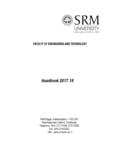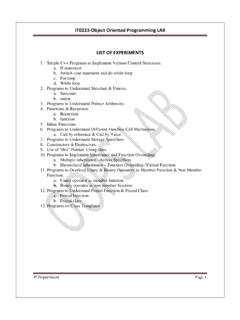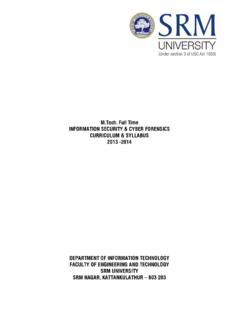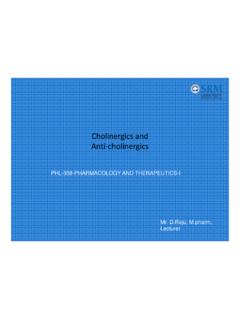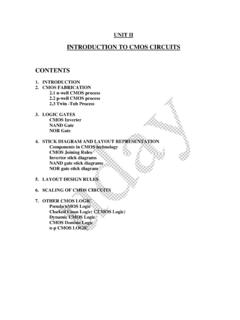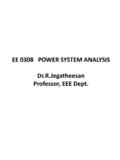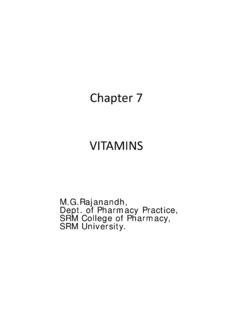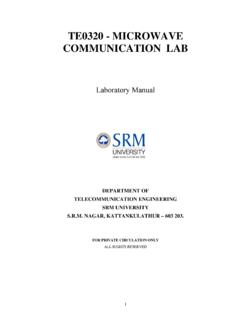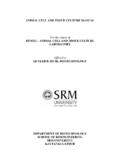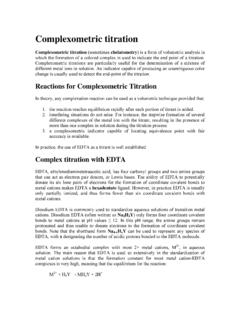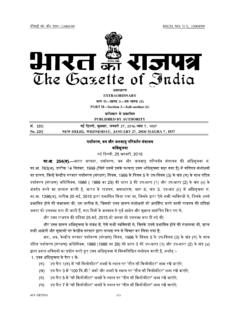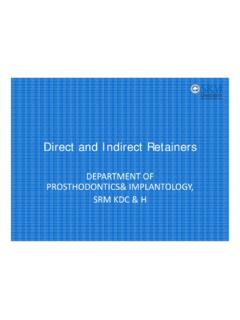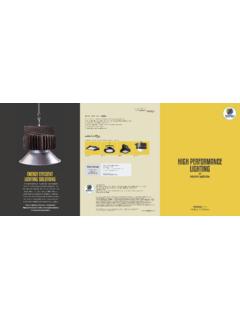Transcription of FORMULATION & EVALUATION OF SHAMPOO
1 FORMULATION & EVALUATION OF OF PHARMACEUTICSSRM COLLEGE OF PHARMACYUNIT VCONTENTS1. Introduction2. Types of Shampoos3. Product Ingredients4. Formulation5. EVALUATION of Shampoos6. ReferencesIntroduction Definition:A SHAMPOO is a preparation of a surfactant ( active material) in a suitable form liquid, solid orpowder which when used under the specified conditionswill remove surface grease, dirt, and skin debris from the hairshaft and scalp without adversely affecting the user. Requirements of a SHAMPOO :1. It should effectively and completely remove dust or soil,excessive sebum or other fatty substances and loose cornealcells from the It should produce a good amount of foam to satisfy thepsychological requirements of the It should be easily removed on rinsing with It should leave the hair non dry, soft, lustrous with goodmanageability and minimum fly It should impart a pleasant fragnance to the It should not cause any side effects / irritation to skin or It should not make the hand rough and of ShampooShampoos are of the following types.
2 Powder SHAMPOO Liquid SHAMPOO Lotion SHAMPOO Cream SHAMPOO Jelly SHAMPOO Aerosol SHAMPOO Specialized SHAMPOO Conditioning SHAMPOO Anti dandruff SHAMPOO Baby SHAMPOO Two Layer ShampooPRODUCT INGREDIENTS Surfactants are the main component of SHAMPOO . Mainly anionicsurfactants are used. The raw materials used in the manufacture of shampoos are:1. Principal surfactants: Provide detergency and Secondary surfactants: Improve detergency, foam and Other ACTION OF SHAMPOOA surfactant consists of two part one hydrophilic (water loving) while the other is hydrophobic in Anionic surfactantsare mostly used (good foamingproperties). The hydrophilic portion carries a negativecharge which results in superior foaming, cleaningand end result attributes. Non ionic surfactants have good cleansing properties but do not have sufficient foaming power.
3 Cationic surfactants are toxic and are hence not used. However, they may be used in low concentration in hair conditioners. Ampholytics, being expensive, are generally not used. However, they are mainly used as secondary surfactants and good benzene sulfonatesSodium dodecyl benzene sulfonateTend to yield an airy or low density foam and often are drying to the hairPrimary alkyl sulfatesLauric acid, stearic acid andtheir saltsGood lathering effect in hard water, free from rancidity, easy to alcohol sulfatesSodium sec lauryl sulfateLow cost, dispersing and emulsifying action, dissapointingas detergets and SHAMPOO componentsAlkyl benzene polyoxyethylenesulfonatesTriton X200 Stable in acid or alkaline solution, excellent emulsifier, detergent and wetting agent; extremely stable at pH of skinSulfated monoglyceridesLauric monoglycerideammonium sulfateStable in hard waterAlkyl ether sulfatesDerivatives of lauryl alcohol ether with PEGGood cleansers, act as solvents for non polar additivesSarcosinesLauroyl and cocoylsarcosinesExcellent foaming and conditioning actionSulfosuccinatesAerosol OTLess irritating to skin and eye (baby SHAMPOO )MayponProtalbinic and lysalbinicacid derivatives (maypon 4C)Hydrolysation product of proteins with fatty acid chlorides in presence of alkaliNON IONIC SURFACTANTSCLASSEXAMPLECOMMENTSF atty acid alkanolamides (should not be used > 15%)
4 Lauric monoethanolamideImproves solubility of SLSS tearic ethanolamidePearlescent thickenerOleic ethanolamidesHair conditioning agentsPolyalkoxylatedderivativesEthoxyla ted fatty alcoholsStable in wide range of pH; stabilizing emulsifying and opacifying propertiesBlock polymers (pluronics)Good rinsability, can be used in high %Sorbitol esters (TWEENS)Solubilizers and emulsifiers, used in baby shampoosAmine oxidesCoconut and dodecyldimethyl amine oxidesFoam booster and anti static agentsAMPHOTERIC SURFACTANTSN alkyl aminoacids aminoacid derivativesFoaming agentsAspargine derivativesCompatible with both anionic and cationic surfactantsBetainsAmido betainsHigh foaming properties, imidazolineMIRANOLTMBaby shampoosADDITIVES Conditioning agents: Lanolin, mineral oil, herbal extracts, egg derivatives.
5 Foam builders:Lauroyl monoethanolamide, sarcosinates Viscosity modifiers : Electrolytes NH4Cl, NaCl Natural gums Gum Karaya, tragacanth, alginates Cellulose derivatives Hydroxyethyl cellulose, methyl cellulose Carboxy vinyl polymers Carbopol 934 Others PVP, phosphate esters. Sequestering agents : EDTA Opacifying agents: Alkanolamides of higher fatty acids, propylene glycol, Mg, Ca and Zn salts of stearic acid, spermaceti, etc. Clarifying agents: Solubilizing alcohols ethanol, isopropanol Phosphates Non ionic solubilizers polyethoxyated alcohols and Perfumes: Herbal, fruity or floral fragnances. Preservatives: Methyl and propyl paraben, formaldehyde (most effective). Anti dandruff agents:Theshampooscontainsmallamount of these actives, which are in contact withthe scalp for only a short time.
6 In order to beeffective the active ingredient must work in the oil waterenvironmentofthescalpandmustbereadi lysubstantive to the scalp for continuing : Selenium sulfide, zinc pyrithone, salicylic SHAMPOOH enna powder5%Soap powder50%Sodium SHAMPOOSLS40%NaCl (to desired viscosity)2 4%WaterUpto 100%Perfume, color, SHAMPOOTLS35%Glyceryl monostearate2%Magnesium stearate1%WaterUpto 100% , SHAMPOOSLS38%Cetyl alcohol7%WaterUpto 100%Color, SHAMPOOSA lkyl dimethyl benzalkonium chloride15%TLS (40%)28%Coconut ditethanolamide7%HPMC1%Water Upto 100%Color, perfume, SHAMPOOTLS60%Coconut diethanolamide2%WaterUpto 90%Propellent10%Color, perfume, preservativeq,.sFORMULATIONSCONDITIONING SHAMPOOSS teryl dimethyl benzyl ammonium glycol monostearate2%Cetyl 100%Color, perfume, LAYER SHAMPOOSLS27%Cocamidopropylamine oxide5%Lauramine DEA1%Lactic acid (50%)1% SHAMPOOM agnesium lauryl sulfate ( )11%Cocamidopropyl betaine (30%)5%Polysorbate 201%PEG acidTo pH (deionised).
7 Aqua (INCI)To 100%FORMULATIONSANTI DANDRUFF 100 Color, perfume, DANDRUFF SHAMPOOS elenium paste35%Waterupto 100 Color, perfume, SHAMPOON atural essential oil tetragonoloba(Guar Gum)1%Camellia sinensis(Green Tea) extract2%Glycerin1%Hydrolysed wheat officinalis(Sage) leaf officinalis(Sage) oleate1%Polysorbate sorbate5%Aloe barbadensis(Aloe vera) minus (Burdock) root coco glucoside 100% EVALUATION of Shampoos Performance characteristics9 Foam and foam stability9 Detergency and cleaning action Effect of water hardness Surface Tension and wetting Surfactant content and analysis9 Rinsing9 Conditioning action Softness Luster Lubricity Body, texture and set retention Irritation and toxicity Dandruff control9 Microbiological assay9 Eye irritancy test Product characteristics9 Fragnance9 Colour9 Consistency9 Package1.
8 Foam and foam stability: The Ross Miles foam column test is accepted. 200 ml of surfactantsolution is dropped into a glass column containing 50ml of the samesolution. The height of the foam generated is measured immediatelyand again after a specified time interval, and is considered proportionalto the volume. Barnett and Powers developed a latherometer to measure the effect ofvariables such as water hardness, type of soil and quantity of soil onfoam speed, volume and stability. Fredell and Read titrated actual standard oiled heads of hair withadditive increments of SHAMPOO until a persistent lather end Detergency and cleaning action: Cleansing power is evaluated by the method of Barnet and Powers 5gm sample of soiled human hair is placed at 35 c in 200 cc of watercontaining of 1 gm of SHAMPOO .
9 The flask is shaken 50 times a minute for 4 minutes. Then washed onceagain with sufficient amount of water, then after filter the hair driedand weighed. The amount of soil is removed under these condition is Wetting Action: Canvas disk sinking test: A mount veron cotton duck # 6 canvas disk 1inch in diameter, is floated on the surface of a solution, and the timerequired for it to sink is measured Rinsing: Skilled beauticians are employed to make comparisons on theperformance of several Conditioning Action: Conditioning action is a difficult property to assess. This is because it isbasically dependent on subjective appraisal. No method has been published for measuring conditioning action. The degree of conditioning given to hair is ultimately judged byshampoo user who is making the EVALUATION on the basis of pastexperience and present Microbiological assay: PREPARATION OF PRE INOCULUMTake the loopful culture ofstaphylococcus aureus (ATCC6532) aseptically and transfer tosterilized and cooled 100 ml SCDM (broth).
10 Mix well. Incubate the broth at 37oC for 24 hrs. PREPARATION OF MEDIASoya bean casein digests medium, soyabean casein digest agar and nutrient agar. PREPARATION OF POUR PLATESS terilized SCD agar (100 ml) iscooled to 40 C and mixed with 5 ml of 24 hrs old pre inoculatedculture. This is immediately poured in plates (340 ml each) and allows toset. MAKING THE WELLS ON AGAR PLATESThe wells are dig on agarplates with sterilised well digger aseptically. Take 100 ml of each sample, add to well aseptically. Incubate theplates at 37oC for 24 hrs to 48 hrs. Observe the effectiveness of sample on culture growing on the agarplate and we can see the effectiveness of sample in the form ofzone of inhibition around each well containing different EVALUATION of eye irritancy: The test calls for dropping ml of liquid SHAMPOO in the conjunctiva sac of one eye of the rabbit , the other eye serving as control.
